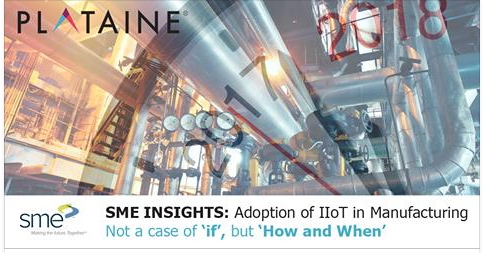I recently had the privilege to speak at the SME Smart Manufacturing event in Los Angeles where I presented at the Digital Transformation seminar. During the event, I met representatives from many leading manufacturers and I came away with four key insights:
- When it comes to IIoT, manufacturers need to ‘jump onboard or die’
The Industrial IoT (IIoT) ensures all products, processes, machines and personnel in a factory are constantly connected. From what I’ve experienced, it’s no longer a question of ‘if’ you need to adopt an IIoT solution, but rather ‘how’ and ‘when’.
Almost every manufacturing executive I spoke to at the SME event told me they are in an evaluation process or are already using connected technology to improve efficiency and quality. It seems as though it doesn’t matter what industry you are in – whether its Aerospace, Automotive, Oil & Gas, wind, etc., – when it comes to IIoT, the choice is simple: join or fade away.
- Chief DIGITAL Officers: Corporates are bringing ‘Digital’ to the C-Suite
The pace of digital change in factorie
That’s where the Chief Digital Officer (CDO) comes in. Many manufacturers at SME told me they’ve already appointed a CDO answering directly to the CEO. This newest member of the C level is there to ensure that the factory places digital technology as top priority, aligning the digital transformation process with the factory’s business strategy.
- Insights and best-practices of advanced manufacturing are about to retire
Times are changing when it comes to knowledge of advanced manufacturing best practices. Many companies at SME mentioned that their veteran managers and operators, who have accumulated decades of experience in production best-practices, have now aged and are about to retire.
Younger recruits bring digital and tech knowledge to the production floor, however they haven’t got a traditional manufacturing background. As manufacturers see people with years of accrued experience retire, they need to think of ways to retain this expertise. Increasingly, they are now turning to software solutions to capture best practices as they maintain traditional knowledge at their firms.
- Traceability of the production floor is becoming crucial for quality
IIoT is giving factories the ability to make massive quality improvements, and many executives at SME told me they particularly value material & part traceability and the digital thread. As they see it, the ability to instantly trace the exact material lot and batch, and digitally document tools and machines used during the production process, is crucial for auditing purposes.
For example, if their material supplier reports a specific faulty batch, the quicker they locate all affected kits and parts and contain the problem before damaged parts are processed or shipped, the better.
Amir Ben-Assa, CMO at Plataine





